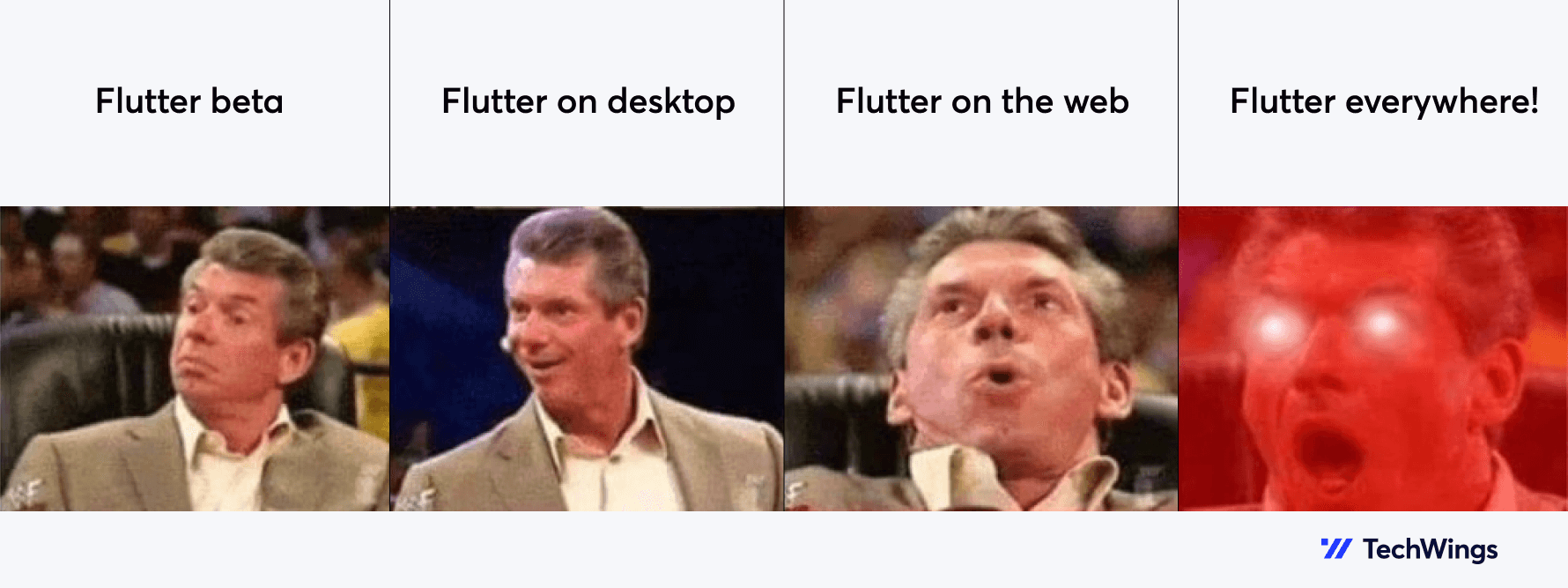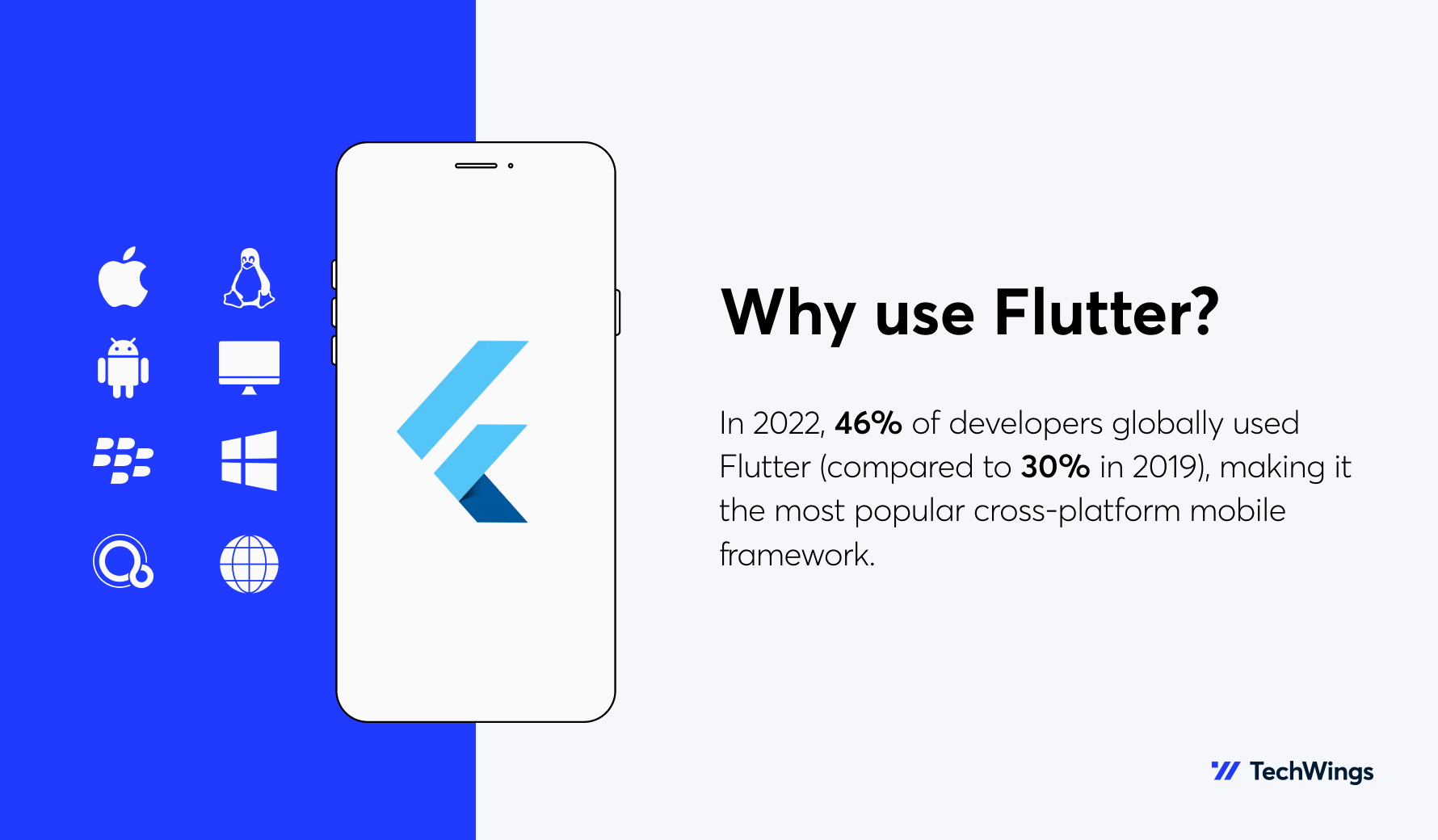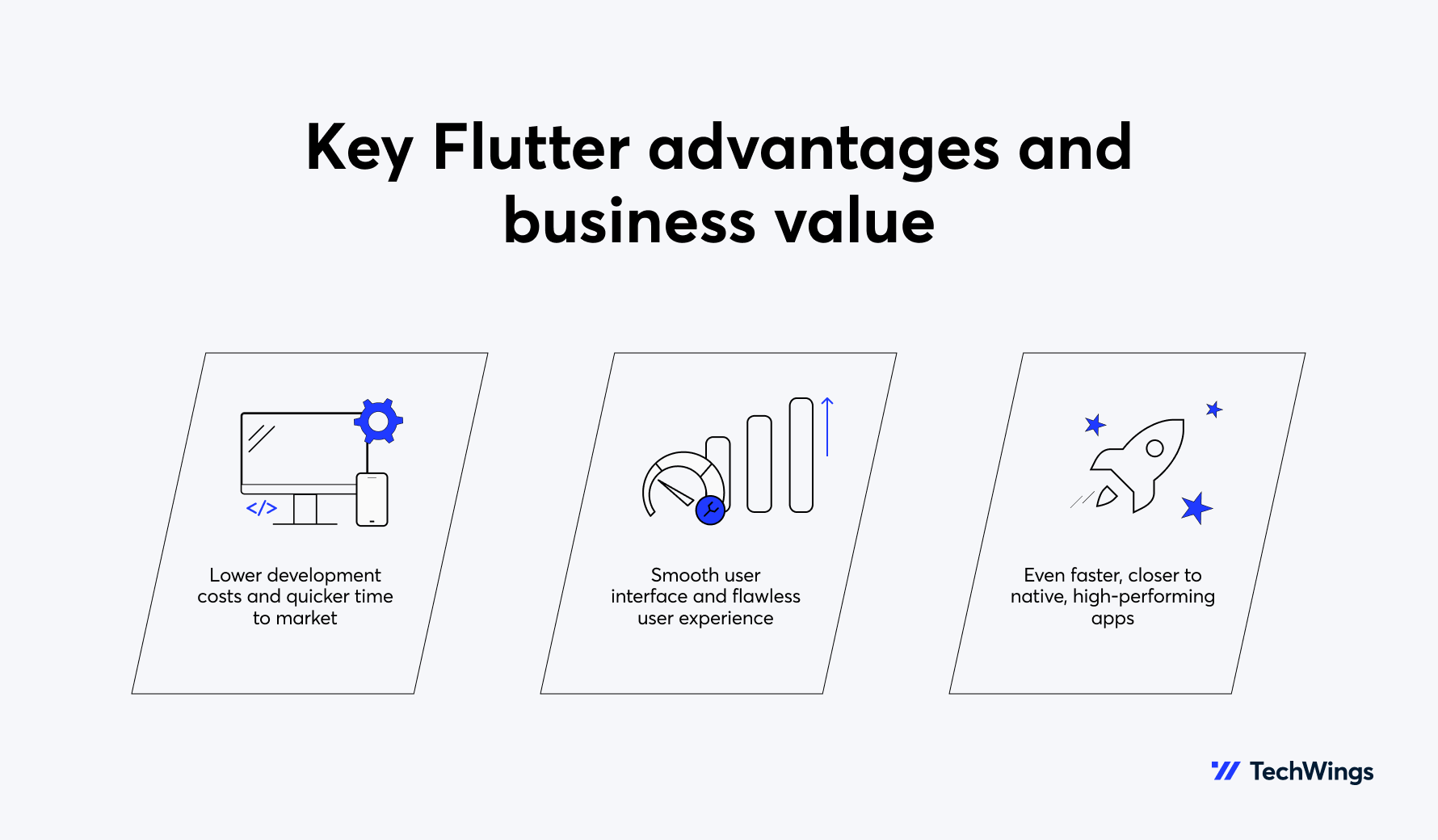Cross-platform development is a cost-effective choice that allows businesses to have the best of Android and iOS platforms. Once you decide to go cross-platform, you’ve got another choice to make: Which cross-platform technology should you use, React Native or Flutter?
If you prefer Flutter app development, stay here. Backed up by the rich experience of our mobile app engineers, this article explains why Flutter is better than other cross-platform technologies.
We’ve rounded up all the major advantages of Flutter app development, focusing on the framework’s unique features and business value.
So why use Flutter? Let’s dive in.
What is Flutter?
Flutter is an open-source UI software development kit launched by Google in 2017. It allows you to develop cross-platform applications that run on Android, iOS, Linux, macOS, Windows, Google Fuchsia, and the web, all from a single codebase.
Flutter apps are written in Dart, an object-oriented programming language with C-style syntax, which allows for creating functional and attractive user interfaces comparable to native Android and iOS apps.
In March 2021, Google announced the launch of Flutter 2, a major upgrade to Flutter that enables developers to build fast and attractive apps for five operating systems and four major browsers.
And that’s not all: Flutter can be embedded in TVs, vehicles, and smart home appliances, providing the most comprehensive experience in the digital world.
Why use Flutter?
In 2022, 46% of developers globally used Flutter (compared to 30% in 2019), making it the most popular cross-platform mobile framework.
But what’s behind its growing popularity? What drives businesses to choose this software development kit for building their applications? Let’s explore the key advantages of Flutter app development.
1. Flutter is cross-platform
When designing a mobile application, the first thing to consider is the platform you want to target. Today, the two leading mobile operating systems are Android and iOS, and many businesses choose to create separate applications for each platform. The main reason for doing so is the native look and feel these applications provide, creating an impression that the app is an integral part of the OS.
However, building two native apps calls for two codebases, two teams, and — let’s face it — two projects that translate into significant development costs.
So, one of the biggest advantages of using Flutter is that it is cross-platform, meaning you can target Android, iOS, Linux, macOS, Windows, Google Fuchsia, and the web without the need to create a separate codebase for each platform. This makes Flutter a cost-effective choice. Likewise, updating your app with new features is a smooth, quick process with Flutter since you only need to update the code once.
Given that, Flutter app development can save you time and resources, letting you focus on improving your app’s functionality and user experience rather than spreading yourself too thin when going for platform-specific development.
Business value: lower costs and faster time to market
Choosing Flutter app development will give you two significant business benefits: lower development costs and quicker time to market.
In addition to targeting multiple platforms simultaneously, the use of Flutter means less code to write — Flutter provides developers with ready-to-use widgets that ensure the same level of performance as native applications.
Moreover, this framework allows developers to build functional applications with platform-agnostic UI components using up to 90% of the code. This saves time and effort, ultimately reducing costs.
While separate apps to target iOS and Android take longer to build, Flutter can completely remove this challenge since you can use the same codebase for both apps.
In addition, Flutter is powered by the hot reload feature, which accelerates the development process by allowing engineers to easily modify the codebase and instantly see their changes in the application.
For example, Reflectly — a personal journal app for fighting negative thoughts built with Flutter — hit the market in just 2.5 months, despite the fact that only two engineers worked on the project.
2. Flutter offers speed, performance, and a native feel
Speed and performance are indisputable benefits of Flutter. The results of the Gauss-Legendre and Borwein algorithm CPU-intensive tests for iOS and Android proved that Flutter apps are fast and high-performing, boasting even higher performance than the native Swift apps for iOS. Flutter’s faster performance is achieved thanks to three factors: Flutter’s DevTools, Skia, and Dart.
Flutter’s DevTools equip developers with profiling, display code coverage, and performance overlay. The latter shows statistics for frames rendered along with their millisecond increments. The optimal frame rate is 60 frames per second, and if this standard isn’t achieved, you’ll fail to provide a smooth user experience.
To make sure each app reaches this standard, Flutter employs the Skia rendering engine, thanks to which UI elements are automatically updated in response to changes in state.
These remarkable features of Flutter wouldn’t exist without Dart, a client-optimized language for building fast-performing apps. Dart leverages ahead-of-time compilation to create fast, near-native Flutter applications without a JavaScript bridge that would decelerate them.
While the shared codebase allows iOS and Android apps to look and perform similarly, Flutter’s Material Design and Cupertino widgets help take user experience to the next level by simulating the platform design. This is possible because these widgets conform to Google’s and Apple’s specific design languages.
Business value: customer loyalty and increased sales
With the benchmark of 60 frames per second, Flutter ensures a smooth user interface. The quality of the user interface directly impacts user experience, which is vital for building user loyalty.
If you fail to provide it, you risk losing your audience. According to a survey conducted during Q2 2022 among mobile gamers in the U.S., 38% of respondents indicated poor user experience as their main reason to uninstall an app.
The use of Flutter for application development ensures smooth performance, going a long way toward retaining customers and strengthening your bottom line.
According to the team at Xianyu (Alibaba Group), China’s largest secondhand marketplace, they chose Flutter to develop an app that looks consistent across platforms, has beautiful graphics, and loads fast.
3. Flutter keeps growing
As already mentioned, Flutter was the most widely used tool for cross-platform development in 2022, outperforming its major rival, React Native. In the years prior to 2022, the number of projects using Flutter had been steadily growing, so Flutter’s number-one position today is anything but surprising.
As stated in the Flutter 2023 strategy, in January 2023, there were more than 700,000 Flutter apps in the Google Play Store, and one in five new apps in the store used Flutter. It is a popular choice with many top companies worldwide, including Toyota, Alibaba Group, eBay, and BMW.
Flutter’s popularity can be explained by its robust cross-platform support and unmatched performance in comparison with other cross-platform tools, which results in cost efficiency, reduced time to market, and greater customer satisfaction.
It’s safe to say that Google has devoted considerable time and resources to creating Flutter, and their team is continuously improving the framework — the launch of Flutter 2, four years after the initial version of the tool had been released, is solid proof of that.
Business value: a secure, future-proof app
As Flutter grows, you can build even faster and higher-performing apps with it. In the world of technology, changes happen daily, meaning that tomorrow Flutter can offer more than it did today.
In 2023, the Flutter team plans to migrate the ecosystem to null safety without fragmentation, keep advancing Dart, remove performance impediments with minimal impact on customer experience, deliver unmatched performance regardless of the platform, minimize or eliminate friction when using system APIs, and maintain and grow their reputation for quality.
This all means that the benefits of Flutter will only strengthen over time.
Unlock Flutter’s impressive potential with TechWings
We hope our post has helped you understand why Flutter is such a popular choice for cross-platform development. Besides being cost- and time-effective, which is typical of any cross-platform tool, Flutter's advantages go far beyond.
Flutter apps are fast and high-performing, which plays a crucial role in user engagement and retention. Also, thanks to the unique features of Flutter, such as the array of widgets offered, applications built with Flutter provide native-like experiences for users. As a result, it is comparable to native tools.
With the impressive business values it provides, Flutter is the way to go if you’re seeking a quick and cost-effective way to hit the market. The team at TechWings can help you build a functional app with an engaging user interface and a rewarding user experience, making the most of Flutter’s capabilities. Contact us today to learn more about efficient and profitable Flutter app development!



